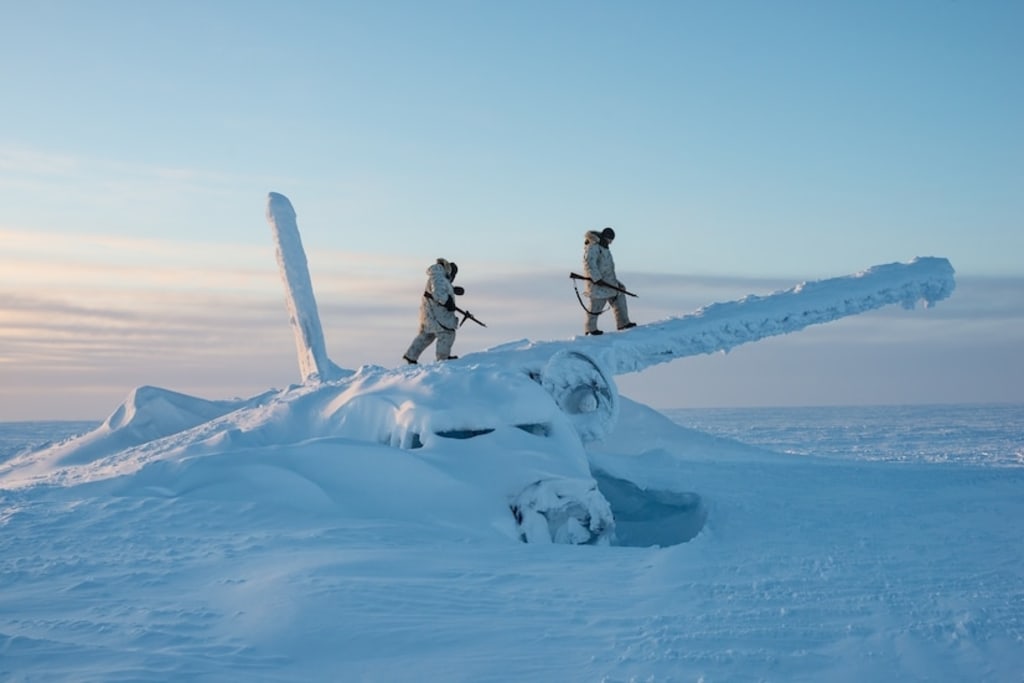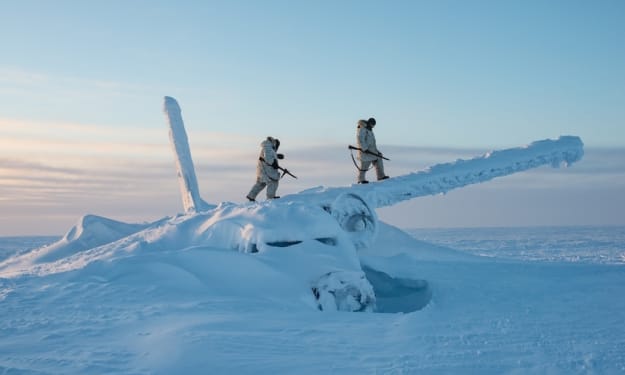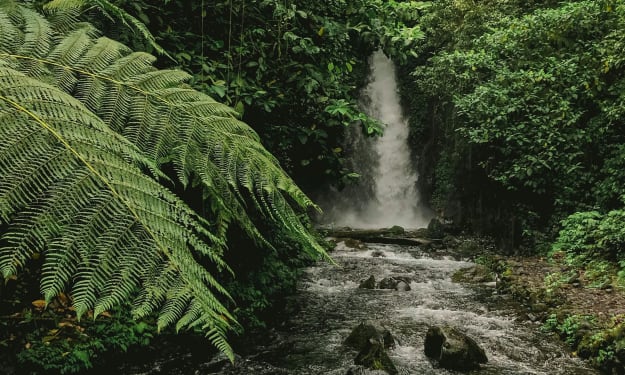
About a week into the rangers’ mission the weather finally broke, and Marvin Atqittuq decided it was time to shoot Russians. He and Sgt. Dean Lushman, a former Canadian infantryman who had become an instructor with the ranger program, hauled out a sheaf of brownish paper targets, stapled them to sticks, and planted half a dozen in the snow outside our camp. Each bore the printed image of a charging soldier, his mouth open in a yell, his rifle mounted with a bayonet. Lushman called them his “Commie squad.”
The targets had been developed for NATO forces during the Cold War. Standing shoulder to shoulder at the foot of a small hill, they were the tallest objects around for miles, so obvious against the snow it didn’t seem possible to miss.
Atqittuq drew a line in the snow 100 yards away and arranged his troops along it. He gave each a handful of bullets, and the rangers knelt onto sealskins or parkas and began firing their clumsy, antique rifles. Atqittuq said age was their only advantage: The old rifles had so few moving parts that they usually didn’t freeze.
I asked Lushman, who had done several combat tours in Afghanistan, if he thought a new Cold War was coming to the north. He laughed.
“Man, look at this.” He spread his arms wide, taking in the empty tundra, the rangers, the paper Russians. “What would anyone do up here? Tanks driving around, soldiers, planes?” He turned to Atqittuq. “Whaddya say, Marv? You ready to fight the Russians?” Atqittuq grinned up from his notebook. “Too much hassle.”
“From a military standpoint, it doesn’t make sense, eh?” Lushman said. “You’ve seen how much time we spend out here just doing basic shit. You’ve seen how often our stuff breaks down, how much work it takes just to survive. Ain’t no war comin’ up here.”
The Canadian Rangers had been created during the first Cold War, when military planners, worried about ballistic missiles and the space race, had looked at the Arctic and seen a vulnerable back door. But the rangers themselves were never intended to battle invading armies. Even now, the eyes and ears of the north are far more likely to watch for passing ships: the Chinese icebreakers, cargo vessels, and cruise ships that are expected to appear in ever greater numbers as ice disappears.
Paul Ikuallaq, one of the rangers on the firing line, had been volunteering with the program for some 30 years. During the Soviet era he had helped train NATO troops. “It was kind of a shit show,” he said.
A barrel-chested, tough-love kind of guy with a rich laugh, Ikuallaq also didn’t believe war would come to the north. The kabloona soldiers he had taught over the years all went home with ice-numbed fingers and toes, reminders of just how bad war in the cold would be.
“Those guys, some of them didn’t even know when they had frostbite on their faces,” Ikuallaq said, laughing. “They didn’t know they could get even whiter.”
While none of the NATO officials I spoke to believed Russia would launch a war in the north, several suggested a conflict might begin somewhere in the south and eventually spread to the Arctic. Some cited Russia’s violent takeover of Crimea and China’s aggressive moves in the South China Sea.
But many outside the military believe there’s still hope for a different Arctic, one that looks less like a Cold War battlefield and more like Antarctica or space. In those regions, both of them also frontiers, international agreements—and distance—dampen the effect of political struggles.
“Countries that have difficulty elsewhere find themselves having to cooperate in cold, dark, dangerous, expensive regions,” said Michael Byers, a professor at the University of British Columbia. “This necessity of cooperation leads to a practice of cooperation.”
On our last evening in camp, well after the sun had set, a small group of young Inuit roared in on snowmobiles. The rangers greeted them, cigarettes began to glow. It was cold but not that cold. The men had been hunting caribou somewhere in the west, without luck.
Suddenly one of the newcomers stumbled into the crowd. He was upset and told of a young man who had been riding in the sled he was towing. The passenger had disappeared. He must have fallen off somewhere out on the tundra. Marvin and other rangers asked for more details, but the young man could only shrug and point. Here was the sort of search-and-rescue mission the rangers had trained for. But before Atqittuq could organize it, a pair of rangers suited up and throttled off.
We watched their headlights streak into the darkness, grow fainter, vanish. Then most of us wandered back to our tents to wait and listen for the whine of returning machines. We made tea. Marvin seemed concerned but not overly so; the missing Inuit had been raised in the Arctic and knew what to do if he found himself alone on the ice. I thought of the bears spotted a couple of days before and tried to imagine what the young man was doing out there. Maybe he was singing hymns.
About the Creator
Adams
writer | artist | chef
Enjoyed the story? Support the Creator.
Subscribe for free to receive all their stories in your feed. You could also pledge your support or give them a one-off tip, letting them know you appreciate their work.





Comments
There are no comments for this story
Be the first to respond and start the conversation.